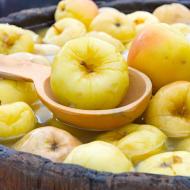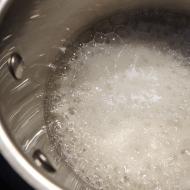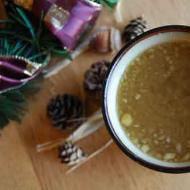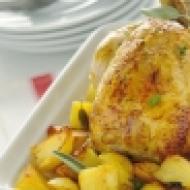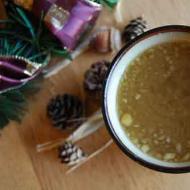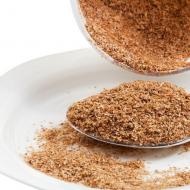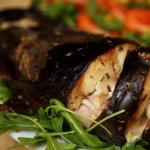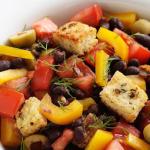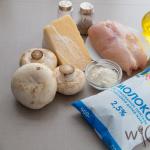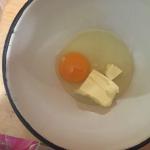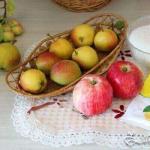
Lasagna - history of origin and recipes. Lasagna - origin story Homemade dough or ready-made sheets
Every inhabitant of our planet knows about the popular Italian dish lasagna, which can win love from the first bite. To prepare modern lasagna, you will need several layers of dried wheat dough (which can later be either boiled or baked) and a variety of fillings (minced meat, vegetables, mushroom stew). Before placing the dish in the oven for baking, sprinkle cheese on top.
However, lasagna was not always like this. Once upon a time, the ancestor of lasagna was a round flat cake made from wheat flour. Laganon is the name given to the flatbread by the Greeks who often baked it. This type of bread was later adopted by the Romans, who cut the flatbread into strips. The Romans began to call their bread lagani.

Residents of some areas of Italy know the wide flat pasta, known throughout the world as tagliatelle, under its second name - lagana. According to the following etymological version, the name “lasagna” comes from the Greek - lasabon. Translated, this means “pot stove.” The Romans called the utensils they used to prepare lasagna lasanum. It turns out that the name “lasagna” was transferred from the dishes to the dish itself.

Not only the British, but even the Scandinavians are trying to defend the pedigree of lasagna, although this dish is considered to be truly Italian. The English version of the history of the origin of lasagna is based on the fact that at the time when King Richard II reigned (XIV century), the “loseyns” dish was already served at his court. According to the British, the original lasana recipe is listed in the book “Forme of Cury” (one of the first cookbooks in England), which is kept in the British Museum. Italians are very jealous of everything related to national cuisine. And that’s why they were very offended by such a bold and arrogant assurance from the British.

But the Italians hardly reacted to the story of lasagna, heard from the Scandinavians. In the Scandinavian version, the langkake dish, strongly reminiscent of lasagne, consisting of bread cakes, a layer of which was cheese and meat sauce, migrated to the modern cuisine of Scandinavia back in Viking times.

The first documented recipe for Italian lasagna was found in the vicinity of Naples. It was an anonymous 14th-century manuscript called Liber de coguina, which translates to cookbook. If you believe this recipe, then the preparation of lasagna in the Middle Ages was carried out as follows: a layer of grated cheese and ground spices was made between sheets of dough boiled in boiling water.

Medieval Italians, by that time, were already familiar with spices (salt, sugar, cloves, pepper, cinnamon, nutmeg and saffron) and used them to prepare their dishes. At least this is mentioned in the book “Lasagne”, authored by A. Clifford Wright (Clifford A., Wright, Lasange, Boston: Little, Brown 1955).
An absolute favorite among many, many Italian dishes. It is popular not only because of its cheesy smoothness and delicate softness, but also because of its endless variety of recipes and variations.
It is believed that lasagna was first prepared in the Italian region of Emilia-Romagna, the most famous city of which is Bologna. And to this day Bologna is considered the “capital of lasagna”.
The Italians are believed to have borrowed the word “lasagna” from the Greeks, from whom the word meant a cauldron for cooking. The Italians simply used the Greek word λάσανα (lasana) to designate the vessel in which the dish was prepared.
However, there are other opinions. Scientists from the British Museum, based on studies of medieval cookbooks, came to their own conclusion. They claim that a dish very similar to lasagna was invented and first prepared at the court of the English King Richard II back in the 14th century. It was served at feasts given by the royal court for gluttonous knights, in halls lined with oak panels, as English scholars pompously described it in English.
 However, immediately after the publication of this study, there was a response statement from the Italian embassy in London. On this note, the probably offended Italian diplomats responded that “whatever this ancient dish is and whatever it is called, it is obviously not the lasagne as we prepare it.”
However, immediately after the publication of this study, there was a response statement from the Italian embassy in London. On this note, the probably offended Italian diplomats responded that “whatever this ancient dish is and whatever it is called, it is obviously not the lasagne as we prepare it.”
The famous Bristol restaurateur Antonio Priscoro also dismissed all the British arguments - “I think this is nonsense. In any case, it was the Romans who brought lasagna to England. This is a typical Italian dish."
No matter which side we recognize as right, one thing is certain - lasagna is a tasty, nutritious dish, and regardless of who and when first invented it, it owes its current popularity to its exceptional culinary qualities and an innumerable variety of options for every taste.
 The modern canonical version of lasagna is a casserole made from six layers of dough, between which is filled with meat, poultry, vegetables, topped with sauce and sprinkled with grated cheese.
The modern canonical version of lasagna is a casserole made from six layers of dough, between which is filled with meat, poultry, vegetables, topped with sauce and sprinkled with grated cheese.
Classic lasagna dough (pasta) is prepared from soft flour with the addition of eggs and olive oil.
Here is one of the recipes for this test:
Ingredients:
600 g flour,
3 eggs,
2 tbsp. l. olive oil,
salt to taste,
water.
Preparation:
It is necessary to sift the flour, which is done not so much to separate foreign impurities as to saturate the flour with oxygen. Pour the flour into a mound onto a cutting board, make a hole in the center of the mound, into which we break the eggs, add salt and olive oil, and gradually adding water, knead the dough. Use as much water as the flour can bind, so add water little by little and with extreme caution. The dough should be very stiff, homogeneous and elastic, which can be checked by pressing with your finger; the pressure mark should immediately disappear.
When the dough is ready, cover it with a damp cloth and put it in the refrigerator for half an hour - an hour.
We cut the finished dough into three parts, each of which we roll out with a rolling pin to a thickness of 1.5-2 mm. And immediately cut into long wide plates or into layers equal in width and length to your lasagna dish. Keep in mind that the rolled out dough should be cut immediately before it dries out and begins to crumble.
The finished plates can be dried or frozen, but in any case, they will need to be lightly cooked before placing them in the mold.
If you don’t want to bother with making lasagna dough yourself, then there are always ready-made lasagna pasta plates on sale that will go perfectly with your dish.
In addition to the dough, an important ingredient that makes this dish so tasty and delicious is, of course, cheese. In the classic Bolognese lasagna, a special type of Parmesan cheese (Parmigiano Reggiano) is used. This is a type of hard granulated, cooked, but not pressed cheese, during the preparation of which the curd and rennet are repeatedly mixed and dried. In other variations of the dish, sometimes several different types of cheese are used, such as ricotta and mozzarella.
The lasagna filling is poured with sauce. For lasagna Bolognese, for example, bechamel sauce is used. However, the variety of sauces for this dish with bechamel is by no means exhausted and amazes with its endless number of types, limited, perhaps, by the imagination of culinary specialists.
Here is one version of bechamel sauce:
Ingredients:
1 medium onion,
1 glass of milk,
1 tbsp. l. butter,
1 tbsp. flour,
salt, black pepper to taste.
Preparation:
Pour boiling milk over the peeled and finely chopped onion and let it brew so that the milk cools and is saturated with the taste and aroma of the onion.
Melt a tablespoon of butter in a frying pan and add flour. Stirring constantly, fry the flour in oil for just a couple of seconds so that the flour does not have time to turn yellow, and immediately begin adding strained milk infused with onions in small portions. Make sure that no lumps form, do not forget to stir constantly! Add salt and black pepper to taste and, stirring constantly, heat, but do not boil, for a couple of minutes.
This is the classic basic way to make béchamel sauce. You can also add pieces of fried veal, thyme and nutmeg to it according to your taste and needs.
Ingredients:
¼ cup olive oil,
2 medium onions,
1 carrot,
4 stalks of celery,
5 cloves of garlic,
½ kg ground beef,
½ kg minced pork,
200 g chopped bacon,
250 g tomato paste,
1 tbsp. milk,
½ glass of white wine,
1 tsp fresh chopped thyme leaves (or dried thyme)
3 cups freshly prepared bechamel sauce,
3-4 sheets of freshly prepared lasagna pasta,
1 tbsp. freshly grated parmesan,
salt, ground black pepper.
Preparation:
Filling: In a large frying pan with a thick bottom, heat the olive oil, add finely chopped onions, carrots, celery, garlic and fry over medium heat for five minutes. When the vegetables become translucent, add minced pork and beef, bacon and fry everything over high heat until golden brown, stirring constantly. When the minced meat is browned, pour milk and wine into it, add tomato paste and thyme, add about one glass of water and simmer everything together for an hour and a half over low heat.
While our filling is stewing, prepare bechamel sauce according to the recipe written above.
When the filling and sauce are ready, preheat the oven to 190 degrees and begin to assemble our lasagna.
Grease the lasagna pan with oil. We put part of the filling on the bottom as the first layer, then put a sheet of lasagne pasta (if you are using store-bought pasta, do not forget to lightly boil it first or just keep it in hot water), cover the pasta with bechamel sauce and lightly sprinkle with cheese. We repeat this 3-4 times and finish everything with a layer of filling, which we pour over with bechamel sauce and generously sprinkle with Parmesan. Bake in the oven for 30-40 minutes until the top of the lasagne is golden brown.
Remove from the oven and let cool for 20 minutes, then slice and serve immediately.
And one more recipe that I, being, albeit in the past, a vegetarian, cannot pass by.
Ingredients:
2 tbsp. olive oil,
200 g young spinach leaves,
1 large yellow bell pepper
1 large red sweet pepper,
2 cloves of garlic,
200 g tomato sauce for pasta (you can use any ready-made one),
1 tsp basilica,
1 tsp marjoram,
8 sheets of lasagna pasta
3 cups homemade cheese,
¼ cup freshly grated Parmesan
1 cup mozzarella, cut into long strips
salt, black pepper to taste.
Preparation:
Heat olive oil in a thick-bottomed frying pan and add finely chopped spinach to it and simmer for 2 minutes. Cut the sweet peppers into small cubes and add to the spinach, squeeze a couple of cloves of garlic there. Simmer for another three minutes until the peppers are soft. Add tomato sauce, salt, pepper, basil, marjoram and simmer for another five minutes, stirring constantly. Remove from heat.
In a separate bowl, mix homemade cheese, Parmesan and ¾ cup mozzarella.
Grease the form for preparing lasagna with oil and lay out the layers as follows: on the bottom - a layer of filling, on top of a sheet of lasagna pasta (don't forget to boil it if you use store-bought), on it a layer of homemade cheese with Parmesan and mozzarella. Repeat until all the pasta sheets are used, there should be a layer of filling on top, on which we spread the remaining cheese mixture, and sprinkle this layer with the remaining ¼ cup of mozzarella. Cover the top of the pan with foil and place in the oven preheated to 190 degrees for 30 minutes. Then remove the foil and continue baking in the oven until the lasagne is golden brown.
Remove from the oven, let cool for 20 minutes, cut into portions and serve.
And sprinkled with Parmesan cheese. However, in regional versions, the composition of the filling can be, in particular, minced meat, tomatoes, spinach, other vegetables, Bolognese sauce, mozzarella or ricotta cheeses.
Etymology
The word "lasagna" originally described a cooking pan. Although the dish is believed to have originated in Italy, the word "lasagna" itself comes from the Greek " λάσανα » (« lasana") or " λάσανον » (« lasanon"), meaning "hot plates" or "to expose to the pot". The word was later borrowed by the Romans as "lasanum", meaning "cooking pot". The Italians then used the word to refer to the dish now known as lasagna.
According to another theory, the word "lasagna" comes from the Greek λάγανον (« Laganon") is a type of flat sheet paste made from dough.
Story
The oldest known recipes for lasagne are described in two cookbooks found in Naples - Anonimo Meridionale dated 1238-1239. And Liber de Coquina(c. 1304-1314). Subsequently, this dish gained fame and became popular not only in Italy, but throughout the world. The first lasagnas were cooked in the oven in special frying pans without a handle, into which a certain number of layers of thin dough were placed, alternating with ragu and Parmesan cheese. In Liguria, sauces (for example, pesto) began to be added to traditional lasagna along with the stew. Sometimes lasagna dough was colored bright green by adding mashed spinach.
In the 16th century, the recipe for lasagna was borrowed and transformed in its own way by Polish cuisine, resulting in lazanka.
Test features
Lasagna dough is made from the same flour used for pasta. This flour is prepared exclusively from durum wheat.
Layers of dough are also produced as pasta and are commercially available as dry sheets of dough.
Modern kitchen
Modern lasagna is made from several layers of dough, each of which is topped with filling and bechamel sauce. Minced meat, mushrooms or vegetables can be used for the filling, and grated cheese on top. For lasagna, Italians most often use cheeses such as ricotta, mozzarella and parmesan. The latter is required only for classic lasagna bolognese. But you can replace this cheese with another hard cheese, Dutch, Russian or Monastyrsky, as it is used to form a golden and crispy crust[[K:Wikipedia:Articles without sources (country: Lua error: callParserFunction: function "#property" was not found. )]][[K:Wikipedia:Articles without sources (country: Lua error: callParserFunction: function "#property" was not found. )]] [ ] . You can also replace mozzarella cheese with other types of soft cheeses - for example, suluguni or feta cheese. Next, the dish is baked in the oven at a temperature of 220 degrees and then lowered to 180 and baked for 30-35 minutes.
Write a review about the article "Lasagna"
Notes
Links
- (English)
Excerpt describing Lasagne
There was a whiff of coldness and spaciousness all around, as if I had unexpectedly plunged into eternity... The feeling was unusual and strange - at the same time it emanated joy and anxiety... I seemed small and insignificant to myself, as if someone wise and huge at that time watched me for a moment, trying to understand who dared to disturb his peace. But soon this feeling disappeared, and only a large and deep, “warm” silence remained...In an emerald, endless clearing, two people sat cross-legged opposite each other... They sat with their eyes closed, without uttering a word. And yet, it was clear - they were saying...
I understood - their thoughts were speaking... My heart was beating wildly, as if wanting to jump out!.. Having tried to somehow gather myself and calm down, so as not to in any way disturb these gathered people who had gone into their mysterious world, I watched them with bated breath, trying remember their images in my soul, because I knew that this would not happen again. Apart from the North, no one else will show me what was so closely connected with our past, with our suffering, but not giving up Earth...
One of those sitting looked very familiar, and, of course, having taken a good look at him, I immediately recognized Svetodar... He had hardly changed, only his hair became shorter. But his face remained almost as young and fresh as on the day when he left Montsegur... The second one was also relatively young and very tall (which was visible even while sitting). His long, white hair, dusted with frost, fell onto his broad shoulders, glowing pure silver under the rays of the sun. This color was very unusual for us - as if it wasn’t real... But what struck us most were his eyes - deep, wise and very large, they shone with the same pure silvery light... As if someone with a generous hand had scattered myriads of silver stars into them. .. The stranger’s face was tough and at the same time kind, collected and detached, as if at the same time he was living not only our Earthly life, but also some other, someone else’s life...
If I understood correctly, this was the one whom the North called the Wanderer. The one who watched...
Both were dressed in long white and red clothes, belted with a thick, twisted, red cord. The world around this unusual couple swayed smoothly, changing its shape, as if they were sitting in some closed, oscillating space, accessible only to the two of them. The air all around was fragrant and cool, it smelled of forest herbs, spruces and raspberries... A light, occasional breeze gently caressed the lush tall grass, leaving in it the smells of distant lilacs, fresh milk and cedar cones... The land here was so surprisingly safe , pure and kind, as if worldly worries did not touch her, human malice did not penetrate into her, as if a deceitful, changeable person had never set foot there...
The two talking stood up and, smiling at each other, began to say goodbye. Svetodar was the first to speak.
– Thank you, Wanderer... Low bow to you. I can't go back, you know. I'm going home. But I remembered your lessons and will pass them on to others. You will always live in my memory, as well as in my heart. Goodbye.
- Go in peace, son of bright people - Svetodar. I'm glad I met you. And I’m sad that I’m saying goodbye to you... I gave you everything that you were able to comprehend... And that you were able to give to others. But this does not mean that people will want to accept what you want to tell them. Remember, knower, a person is responsible for his own choice. Not gods, not fate - only man himself! And until he understands this, the Earth will not change, it will not get better... Have an easy journey home, dedicated. May your Faith protect you. And may our Family help you...
Cuisine lasagna is very easy to prepare if you know the sequence and some secrets. After all, what is lasagna? This is a cross between a casserole and a pie. It is prepared only in the oven. It uses an equally traditional sauce for Italy - Bolognese.
Traditional dish of the Apennine Peninsula
If you ask an Italian what lasagna is and how to prepare it, he will answer that it is a very simple dish. You need to buy lasagna, mozzarella or ricotta and bolognese, lay everything in layers and put it in the oven for half an hour. In fact, about what lasagna is and how to prepare it, it is better to ask travelers or compatriots who have lived in the Apennines for a long time. They will explain that the dish consists of unleavened dough and cheese, placed on top of each other in a certain order, as well as two sauces: a white type of French bechamel and meat bolognese.

Is lasagna a dish or a pasta of a certain shape?
In our article you can clearly see what lasagna is. The photographs demonstrate it perfectly. It should be noted that, unlike us, Italians do not sprinkle cheese on top of their national dish so that it melts in the oven and covers the dish with a golden brown crust, and the part that seeps inside begins to stretch in long threads. They use parmesan instead of salt and mozzarella instead of sour cream.

Bolognese
The most important component of lasagna is the Bolognese meat sauce. You can buy it ready-made, or you can prepare it yourself. It is made from ground beef, red wine and vegetables. Minced meat is combined with green pesto sauce or red tomatoes. Russians prefer red Bolognese. Our compatriots, when asked what lasagna is, usually answer that it is a layered casserole, similar to a pie, with a red tomato and meat filling.
Italians often use ready-made store-bought sauce, since it takes a very long time to prepare at home. The minced meat should be simmered over low heat for several hours, at least four, constantly adding red wine to it. When the minced meat becomes soft, it is seasoned with salt, pepper and other spices and seasonings to the taste of the cook. This can be dill, parsley, celery, marjoram, basil, oregano, cloves, allspice, thyme, rosemary, garlic, etc. Carrots, onions, other vegetables depending on the season and peeled tomatoes are sautéed separately. When the meat is almost done, all these ingredients are mixed and simmered together for a few minutes.

White sauce
White sauce like béchamel began to be added to lasagna thanks to the light hand of European travelers. Italians add mozzarella or ricotta to their lasagna. But they are very difficult to find outside of Italy. Although these cheeses resemble feta cheese or suluguni, lasagna is still more often made with white bechamel sauce. For it, lightly fry the flour, cool, add warm milk, butter and nutmeg and, stirring thoroughly to prevent the formation of lumps, bring to thickening over low heat. No need to add salt. Grated Parmesan cheese will accomplish this task.

Homemade dough or ready-made plates?
If you go to a supermarket and ask where to find lasagna, you may hear a counter question in response: “Are you interested in plates or frozen fast food?” After all, what is lasagna? Sheets of unleavened dough, one of the types of pasta. They usually lie on the shelves next to large tubes of cannelloni, strings of thin spaghetti, flat and long fettuccine, tiny anelle, etc. Listing the names of Italian pasta is a thankless task. There are more than a hundred of them. We are only interested in lasagna. It is impossible to confuse or not recognize these large sheets. They are made from flour and water.
You can make the sheets for the dish yourself, but it’s easier to buy ready-made ones. Some recipes recommend boiling them before using. This is a gross violation of lasagna preparation technology. Don't be afraid to put hard sheets into the mold. Bolognese and bechamel sauces are quite liquid. They will perfectly soften and soak hard dough sheets.

Layer placement is an important issue
Place Teflon-coated baking paper on the bottom of a thick-walled rectangular pan. Lay lasagna sheets on it in one layer. If they overlap each other a little, it’s not scary. This is completely acceptable. These sheets are filled with half the Bolognese mass. Place half the bechamel sauce on top and sprinkle thickly with grated Parmesan. Next is another layer of dough sheets. The second half of the bolognese mass and bechamel are placed on it. The mold must be covered with foil or a lid and placed in a hot oven.
Bake at 220 degrees for 30 minutes. Then reduce the heat to low and keep the lasagna in the oven for another 10 minutes. Serve hot. It is more convenient to apply using two spatulas. This requires a certain skill and accuracy. To avoid spreading and falling apart, the portion plate should be kept close.

After reading our article, you learned about what lasagna is. It's really not very difficult to prepare it. After all, this dish is a peasant dish. And people who do physical work every day usually don’t have time to spend a lot of time at the stove, creating masterpieces of culinary art. And when asked what lasagna is, you can safely answer: “This is a very tasty meat casserole with cheese and layers of unleavened dough.”
Modern lasagna is a couple of layers of dried and then boiled or baked wheat dough, interspersed with a variety of fillings - from minced meat to vegetable or mushroom stew, then the dish is sprinkled with grated cheese and baked in the oven.
But lasagna was not always like this. The ancestor of lasagna was a flat round cake made from wheat bread. The Greeks baked such a flatbread and called it laganon.
The Romans, who then adopted their bread from the Greeks, began to cut it into strips and call it lagani, i.e. laganon plural. Until now, in some regions of Italy (Calabria, for example), wide flat pasta, known throughout the world as tagliatelle, is also called lagana.
According to the second etymological version, the word “lasagna” comes from the Greek lasanon, which means “pot oven”.
The Romans borrowed this word, reincarnating it as lasanum, which was the name for the dishes in which the “ancestors” of lasagna were prepared. Gradually, the name of the dish passed on to the dish itself.
This is how lasagna was born. And despite the fact that it is now generally accepted that lasagna is authentic Italian, the British and even the Scandinavians are trying to defend its ancestry!
The version of British origin is based on the fact that a similar dish, “loseyns” (pronounced “lasan”), existed at the court of King Richard II back in the 14th century.
The British claim that a unique lasanne recipe can be found in one of the first British cookbooks, “Forme of Cury,” which is kept in the English Museum.
Such a brave and arrogant statement struck a nerve among the Italians, the Italian consulate in London even hastened to make a statement: “No matter what this old British dish was called, it was definitely not the lasagna we make.”
Yes, Italians are very jealous when it comes to national cuisine... True, they practically did not react to the Scandinavians when they heard the story of the Viking times, from whose cuisine the dish “langkake” migrated to modern Scandinavian cuisine, which, indeed, is very similar for lasagna - it consists of bread flatbreads layered with meat sauce and cheese.
Apparently, we shouldn’t pay attention to this version either. The first written Italian recipe for lasagna was in great demand in an anonymous 14th-century manuscript found in the vicinity of Naples. The manuscript was called Liber de coquina (Cooking Book).
According to this recipe, in the Middle Ages lasagna was prepared as follows: pages of dough were boiled in boiling water, sandwiched with ground spices and grated cheese.
The spices probably meant salt, pepper and sugar, but probably also a combination of cinnamon, cloves, nutmeg and.
By that time, medieval Italians were familiar with these seasonings, at least as stated in A. Clifford Wright’s book “Lasagne” (Clifford A. Wright, Lasagne, Boston: Little, Brown, 1995).
One of the biggest lasagna lovers of all time is the wonderful Garfield, a fictional cat from popular American comic books.
Lasagna recipes
Several recipes for making lasagna at home.
Classic lasagna
Products and ingredients:
- parmesan cheese,
- about three hundred grams of minced beef,
- piece of ham 200 grams,
- carrot,
- petiole celery,
- half a glass of olive oil,
- one glass of wine (red),
- several canned tomatoes, with the skin removed,
- salt, pepper to taste.
For the sauce:
- half a liter of milk,
- two tablespoons of flour,
- ground nutmeg (pinch),
- one bay leaf,
- one hundred grams of butter,
- salt to taste.
Preparing the Lasagne recipe:
To prepare lasagna, we buy special plates of dried dough for it. You can, of course, prepare the dough yourself, but having everything ready saves effort and time.
To prepare this dish we also need: Parmesan cheese, about three hundred grams of minced beef, a piece of ham weighing 200 grams, carrots, stalked celery, half a glass of olive oil, one glass of wine (red), several canned tomatoes with the skin removed , salt, pepper to taste.
To prepare the sauce for lasagna we need: half a liter of milk, two tablespoons of flour, ground nutmeg (pinch), one bay leaf, one hundred grams of butter, salt to taste.
Cooking lasagna
First, let's prepare the meat sauce. To do this, add finely chopped garlic and onions to the heated olive oil. Stirring, fry until transparent.
Next, add finely chopped celery and grated carrots. Simmer all this for ten minutes, then add minced beef and finely chopped ham. Stirring, we bring this sauce to the condition when the minced meat is ready.
Then pour in red wine and cook the sauce for another ten minutes. Finely chop the canned tomatoes and add them to our sauce, continuing to boil it all for another forty minutes.
Preparing the second sauce for lasagna
In a dry frying pan, fry the flour with the addition of butter. When the flour turns golden, pour milk into it, which we boiled separately, adding nutmeg and bay leaf (you need to remove it later).
Mix the flour and milk thoroughly so that there are no lumps and bring it to a boil. Let the sauce sit for another ten minutes, adding salt to taste.
“Assembling” lasagna
Take a tall baking dish and pour the meat sauce into it (a little). Carefully place sheets of dry dough on it. Then pour more meat sauce on top.
Pour our milk sauce over it, sprinkling it with grated Parmesan. The next layer is sheets of dry dough. Alternate layers in the order described above until the meat sauce runs out.
The last layer is sheets of dry dough, poured with milk and flour sauce and sprinkled with cheese. And now - the final stage.
In an oven heated to 200 degrees, place our pan with sauces and layers of dough and bake until golden brown. This will take about thirty minutes.
Lasagna with vegetables

Products and ingredients:
- - 2 pcs. (filling)
- Paprika – 2 pcs. (filling)
- Eggplants – 2 pcs. (filling)
- Eggs – 3 (dough)
- Flour – 300 gr. (dough)
- Olive oil – 2 tablespoons.
- Garlic – 3 cloves (to taste)
- Onion - 2 pcs.
- Mushrooms – 100 gr.
- Canned tomatoes – 100 gr.
- Cheddar cheese – 100 gr. (shabby)
Preparation of the recipe Lasagna with vegetables:
Roll out the finished dough into several layers. Then fry the onion and garlic in olive oil, then add zucchini, eggplant and paprika, when the vegetables become softer, add mushrooms, tomato paste and tomatoes. Simmer for 15 minutes and do not cover with a lid.
Place 2 layers of dough on a greased baking dish, and make the next layer with prepared vegetables. Then again a layer of dough and a layer of vegetables, etc. Sprinkle with cheese (grated). Bake in a hot oven for approximately 40 minutes. until it turns golden.

